Weddings in Modern Judiasm

On June 17, l990 I attended the wedding of Keiko Christine Owada, daughter of Professor Yasuyuk Owadai and Mrs. Judy Owada. She was married to Michael Gregory Paros, son of Jerome and Linda Paros. The setting was just in front of the Alumni House at the University of Redlands.
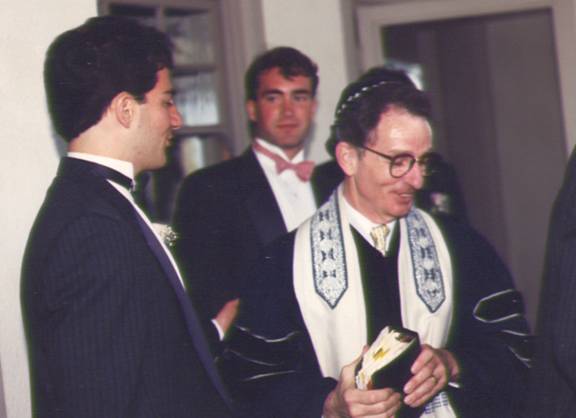
There were many memorable aspects to this wedding. It was the first time I had seen Rabbi Hillel Cohn, Rabbi of the Temple Emanuel in San Bernardino, officiate in a wedding ceremony. He is pictured above with Mike.
I liked learning that Keiko wore the same wedding dress that had been worn by her grandmother on her wedding day, 60 years earlier. The dress cost one weeks salary: $9.00. ( My wife wore her grandmother’s dress in our wedding. Cf. above "Decades" then "1960's") But in this case I learned that Keiko wore Mike'sgrandmother’s dress. That was unique!
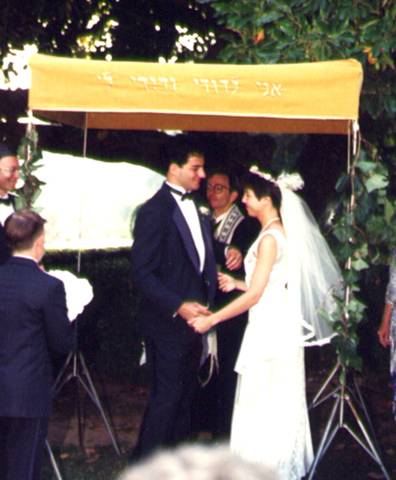
Michael’s grandmother, Mrs. Betty Paros, was witness to this wedding. The fact that the bride and groom are standing under the Chuppah would also have pleased Michael’s grandmother. In the picture above one can see that Michael is looking directly at Keiko with Rabbi Cohn in the background, earlier they had faced the Rabbi and Keiko stood on the right side of Michael, in contrast to Protestant weddings.

In Jewish ceremonies, a Ketubah (wedding contract) was written before the wedding and signed by both bride, groom and the witnesses. Rabbi Cohn recently wrote me in an email that “the traditional Ketubah is a document in which the bridegroom promises to take care of the bride. Today there are more equalized forms of the Ketubah that are often used in non-Orthodox Jewish weddings". There are also interfaith Ketuboth (i.e. the plural). The process of have such a written document in Jewish wedding can be seen in one stage in the Book of Ruth when Boaz calls a group to witness his wedding vow to Ruth, wording. ( Cf. above"Weddings around the World" then “The Wedding of Adam and Eve.”)
Keiko and Michael’s Ketubah now hangs on their bedroom wall in a place of honor in the most intimate place in their house. Theirs has Hebrew characters at the bottom and Japanese Kanji at the top. The upper part is a composition of Dr. Yasuyuki Owada which I discovered in the research for my "wedding album" project starts with the observation that since both Mike and Keiko were born on the very same day October 5, l967 that they arrived in the world and would hopefully be friends not only in this life but into eternity. Thereafter, Dr. Owada borrowed some thoughts, if through the Japanese document into a Jewish Ketubah from a famous poem of Kahil Gibran.
At the beginning of the wedding reception Michael's grandfather, Mr. Bennett Lee, offered a traditional blessing over the challah (the bread) and then offered it to the guests. " Grandpa Lee," was a devout man, who instructed Michael has in Jewish teachings when a boy.
Rabbi Cohn thereafter send an email including the words of the blessing ( MOTZI)
Baruch atta Adonye eloheynu melech ha-olam ha-MOTZI lechem min ha-arets.
(Blessed be You, God, ruler of the Universe, who brings forth bread from the earth.)
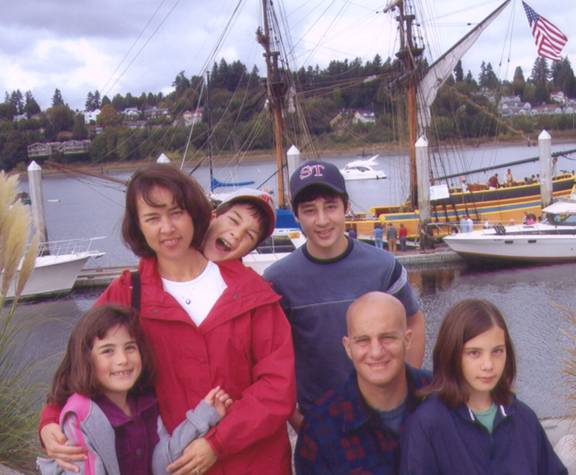
Above is a picture of Keiko and Michael and their family in 2005 at the Port of Olympia, WA with a ship used in" Pirates of the Caribbean" docked in the background. Sam in the hat had already had his Bar Mitzvah by this time, Hana on the right must have been thinking about her Bat Mitzvah which would soon come. Mike has no hat and no hair for he was undergoing chemotherapy for cancer, which is now in remission. His hair has come back, his smile has remained, and he is now practicing as a veterinarian in Washington State while he is also teaching full time at Evergreen State University.
(2) With some weddings I have no picture, but a wedding invitation can serve to remind me of a ceremony of a student I taught who wished to have me present since I had known her through two classes.
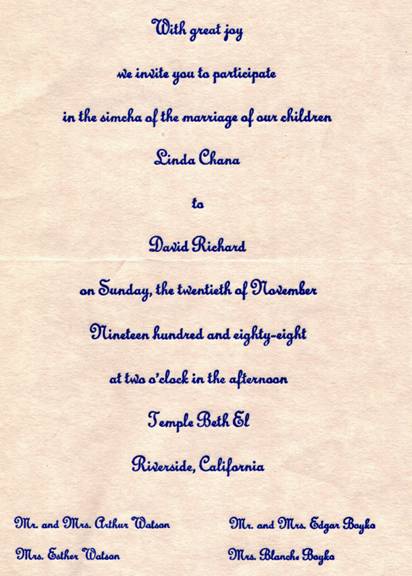
Linda Watson took both my Hebrew Language and Hebrew Scriptures classes, doing excellent work in both at least two years before she sent the invitation, and I had gone to her graduation in l986. It is not a wedding picture, but it is the only one I have of her. I remember now that while she was taking the Hebrew Scriptures course Linda was contemplating a conversion to Judaism. Indeed, in the two years from her graduation until the wedding, she was able to complete all the requirements for her conversion. Perhaps neither of us imagined that her conversion would lead to the marriage with David Boyko. Linda, on the right below with her classmate Sue DuBord brought joy to the occassion, and to look at the two of them now brings a lingering inspiration at their lives and achievements.
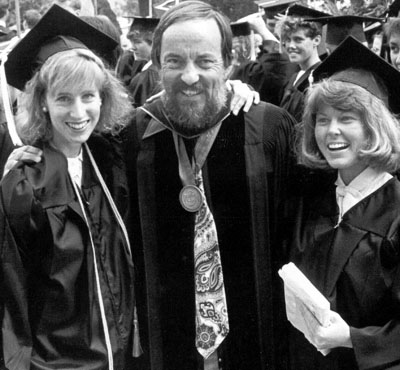
photo: watsonandeme.jpg by University of Redlands photographer
I met David Richard Boyko for the first time at their wedding n Riverside California at the Temple BetheI, a Conservative temple. Many year before I had beena guest in the Conservative temple in Charlotte, N. C. with my Jewish dentist. I was accustomed to the women sitting on one side of the temple and the men on the other. I was aware that a good deal of Hebrew would be used, for that is one dimension of the practice of Conservative Jews, when one compares them with the practice of Reformed Jews. At that time and again at Linda's wedding I liked the use of Hebrew, for I was studying the language as part of my graduate work at Duke University in those years. I also was invited once to the home of the Conservative rabbi in Charlotte, and we walked from the temple there to his house, about a mile, in observance of the Sabbath. Walking is appropriate, not riding. I remember falling of his poarch into a bush, because he had not lighted the candle on his poarch before sundown, and we arrived there after the sun had set. It was a memorable lesson of keeping the law!
Her wedding was the first time for me to experience the beauty of a Jewish wedding in a Jewish sanctuary. I have been to several Jewish weddings in other buildings and in the outdoors. In each case there hasbeen a rabbi to perform the ceremony, and a Chupa was used. Moreover, I have conducted ceremonies in which a bride or groom had clear roots in Jewish culture, but they were having a wedding with a person who was not Jewish, and they knew I would happily do the ceremonies, although many times rabbis would refuse. Once I performed a ceremony in which a rabbi had a part in the ceremony, the Blessing. (cf. The wedding of Tim Krantz in the section "Weddings of Faculty").
We received a beautiful program at the wedding. I realized that the Rabbi Marvin Labinger, who conducted the ceremony was a chaplain in the U. S. Army with the rank of a colonel. Moreover, I saw David in uniform with his three groomsmen, also officers in the U. S. Army, Capt. Mark Coleman, Capt. Dan Altobelli and 1st Lt. Andy Martyniuk. I was thereby reminded it was the most military looking ceremony since the two weddings of the 1950's when I wore my U. S. Navy dress whites in the weddings of 2nd Lt. Rudy Ruda in his Marine dress and Lt. John Hunt, in his Navy dress whites (Cf. above, "Decades" then "1950s").
In the Processional, Chaplain Labinger enter the synagogue first, then came the groomsmen, followed by David with his parents Mr. Edgar Paul Boyko and Mrs. Blanche Boyko. Then came Linda's bridesmaids Miss Kima Garten and Mrs. Sharon Rutledge followed by Linda's sister, Miss Lori Watson. When Linda entered, I noted her Hebrew name "Chana" with her father and mother Mr. Arthur Watson and Mrs. Esther Watson.
The songs used in Linda's wedding processional were as follows:
"Shalom Rav"--"O Lord, may we never become complacent, falter in our effort to build a world of peace for Your children. Let the nations know and understand that justice and right are better than conquest and dominion; may they come to see that it is not by might nor by power, but by Your spirit, that life prevails."
Then "Dodi Li (from the Song of Songs)" in English translation.--"My beloved is mine and I am his that feedeth among the lillies. Who is that going up from the wilderness, burning myrrh and frankincense? You have ravish my hear, my sister, my bride. Awaken, North Wind, and come, O South Wind."
Then "Erev Shel Shoshanim (from the Song of Songs)." --"An evening (fragrant) with roses, pray let us go out to the fruit garden, spices and frankincense for your feet. Night is slowly falling, the fragrance of the rose descends. Come I will whisper to you a song, quietly a song of love. Morning, the dove is cooing, your hair is filled with dewdrops; your mouth (turned ) to the morning, (like) a lily I will pluck it for me."
From the program I learned that a wedding in the Conservative Jewish tradition consists of two ceremonies. In ancient times, before Judaism was divided into the branches we now find, the two ceremonies were "separated by a year, but for almost one thousand years they have (now) been performed together."
The first ceremony or now the first part is the KIDDUSHIN ( betrothal) which l has its roots in the Hebrew word for "holy or KADOSH" which is a legal contract containing obligations of the couple to each other living together as husband and wife. Rings are exchanged at this time and the KETHUBAH (marriage contract) has been written down and is then read.
The second part called the nuptials (NISSUIN) has seven blessings with elements from the span of Jewish history. It reminds the couple of the Creation, the Exile and the Messianic Age. This part of the wedding joins the two individuals, male and female in what is "a smaller scale of the wholeness that the world once knew and will know again."
In the KIDDUSHIN we heard the rabbi's greeting, an opening blessing, a prayer of sanctification, the betrothal blessing, the ring ceremony and the reading of the KETHUBAH.
In the NISSUN, we heard the seven blessings. Then came the conclusion with some thoughts from the rabbi and the breaking of the glass, which is "a reminder of the destruction of the Temple; of the sufferings of the Jewish people; that the world is broken and requires our care to mend it; and of the fragility of life and relationships. This Talmudic custom reminds us that, until the world is once again whole, where there is rejoicing, there should be trembling."
In the recessional, "OD YISHAMA" was chanted as follows:--"Again may there be heard in the cities of Judah and in the streets of Jerusalem the voice of gladness, the voice of bridegroom and bride."(unpublished program of "The wedding Linda Chana Watso to David Richard Boyko" (1988). Riverside, CA. Temple Beth El).
When Jews have come to me to discuss their wedding plans, I have sometimes recommended reading a delightful book, Gross (1996) Under the Wedding Canopy: Love and Marriage in Judaism; Memorable aspects of Jewish weddings are discussed which might inspire those thinking about their wedding ceremony.
Gross states
that all aspects of our daily life give an opportunity for striving for holiness “Meals, work, play, study: all must be hallowed” (Gross, 50). In that same topic of recommendations for reading, Rabbi Hillel Cohn suggested that for a Jewish ceremony reading Helen Latner’s The Everything Jewish Wedding Book would be helpful; for he considers Latner's book to be excellent.
I also liked reading about the practice that in Israel when a boy is born a cedar tree is planted, when he has a wedding, branches are cut and held aloft in the wedding canopy and with the cost of real estate, both sets of parents start saving money for the first home of the couple, well not yet a couple, but an imagined nuptial gift. (Gross 62.) Rabbi Cohn noted that this practice is rare in recent times. Also one learns that the idea of giving a gift, at least in the Jewish context of a ring at a ceremony goes back to an n earlier time when the ring worn at a wedding was given by the father in law to the groom. Clearly it is part of a contribution of economic resources to help support a couple. I laughed aloud in a computer room while reading some Yiddish proverbs which deal with marriage:
Even a bad match can produce good children.
The man who marries for money—earns it.
Husband and wife are one flesh, but have separate purses.
The wedding ceremony lasts an hour but the troubles last a lifetime.
There is no secret from one’s wife. (Gross, 148)
An historical perspective in this book from the Biblical, through the Rabbinical, the Medieval and Modern periods was used to great advantage. One can find the roots for such things as wedding rings, as breaking of glass (the fall of Jerusalem). But some elements which have not been used in recent times are also instructive, and there is overall openness and an affirming of joy, pleasure, love and devotion which are hard to find in many of the 465 books in print on weddings and marriage.
These customs are usually strictly adhered to. To fail to follow they may mean one of the nuptial partners may have grounds for a divorce agreement, if either might want to be released from the marriage.
In fact, it is affirmed a modern Jewish wedding has these three elements which were present from the First Century of the Common Era.
The Jewish marriage is the most important means we have of preserving the Jewish biological strain. Judaism places a great emphasis on couples being from the seed of Abraham. (Cf. Aruch (no date) Jewish Book of Laws. Gansfried: New York).
For a person planning a Jewish marriage, Diamant (1995) gives a great deal of topics which she said she wished that she had known as she planned her own wedding. She not only included my favorite poem, included in the Appendix, “the Eighth Day of Creation,” but she comments on appropriate music, the use of candles, the clothing from both Ashkenazi and Sephardic branches of Judaism, the food, use of photographers, and many other topics.
Marriage can be one of the factors serving the biological strain, “the seed of Abraham.” I was more than a little surprise, when following up on a hunch from my wife, who was teaching a session on Holocaust Literature in her World Literature Class, when she asked if there might have been weddings at the Teresienstadt Concentration Camp, where the Nazi’s fabricated an “idealized” camp for visitors from the Red Cross to deceive them of the life in the other “real” camps, where 6,000,000 Jewish people were being murdered. I discovered that indeed there was at least one wedding in the camp, but I could not find what that ceremony used was. I discovered a source on the topic. “While prisoners in Teresienstadt (Terezin) concentration camp, Jewish women. ... The book explores weddings around the world through photographs and simple ..."
(mercury.educ.kent.edu/database/eureka/eurekaresult_keywordsearch.cfm?Keywords=Emotions-Personal%20Issues )'
During research for the "album project," I wanted to determine what a wedding ceremony was like in present day Israel. During my one sojourn there a decade ago, during Passover, I saw no weddings, nor would I very likely have “crashed” one. I learned that in Israel all authority over marriage of Jews in that country is under the control of Orthodox rabbis and by law the only marriages which are recognized there were performed by Orthodox rabbis for Jewish couples or in civil ceremonies abroad. Therefore, “the Orthodox culture represents, in many ways, a sort of anti-culture to the rest of Israeli society. As a result, the right to marry according to one’s own world-view is for many seculars a matter of principle. A claim often hear is: we would like to have a Jewish ceremony but resent the strict and unequal character of the Orthodox ceremony, and the fact that the state prohibits freedom of choice in marriages.” (Oz, 74). So the couple who wishes a wedding ceremony in the Reform or Conservative traditions or in a secular ceremony can, indeed, have one, BUT they must still have a civil marriage abroad recorded through the Ministry of the Interior. Some efforts are going on at the national level for changes to these laws.
Rabbi Hillel Cohn recently sent me in private corresondence a version of the ceremony he performs,as follows:
"WEDDING CEREMONY
PROCESSIONAL
Rabbi: " The two of you, BRIDE and GROOM, have obviously come to love each other deeply and seriously and have now come to the moment in your relationship with each other of joining your lives together in marriage. Marriage is defined in many ways. It is above all else the joyous coming together of a woman and a man whose friendship has blossomed and flowered into what they recognize a love and those who look upon them recognize as love. And so all of us rejoice with you and for you in that new dimension of life that begins in these sacred moments. The two of you have chosen to join your lives together in a ceremony which enables both of your traditions and faiths to be expressed and that is a reflection of the deep faith that each of you possesses. You stand beneath a Chuppah, the traditional Jewish marriage canopy, which for so long has been a symbol that the two of you are building a home together and that your home must always be distinguished by its good values. Let your home be a place of sanctity and holiness just as marriage is termed Kiddushin, an act of sanctity and holiness. Let your home be set apart from so many others for its decency and beauty".
Rabbi: "We welcome you in words that have been spoken for centuries in moments such as this.
Blessed are those who come in the name of God, we bless you in this, a House of God.
Give thanks unto the Lord for the Lord is good, God's lovingkindness endures forever.
This is a day which the Lord has made, therefore we are glad and we rejoice in it.
"O God, supremely blessed, supreme in might and glory, guide and bless this bridegroom an this bride.
Rabbi The two of you will now share from a first cup of wine which is traditionally the Cup of Betrothal. It is a reminder that you must always share together the varied experiences of life. When those experiences are difficult and trying be sources of strength and encouragement to one another and when those experiences are happy let the sharing of those experiences make them doubly gladdened and doubly sweetened.
"Blessed is God, ruler of the universe, creator of the fruit of the vine. Blessed is God, ruler of the universe, who enables us to sanctify life through marriage under the canopy and commitments of sanctity.
(the bride and groom share in drinking from the cup of wine
The two of you have obviously spoken of your love for one another in many ways and will continue to do so. Now we ask you, in the presence of this assembly of loved ones and friends, to give public utterance to the bond that has come to link your live together."
Rabbi : "GROOM will you now take BRIDE to be your wife, promising to cherish and protect her, whether in good fortune or in adversity, and to seek together with her a life as taught to you by the traditions of the Jewish People, then say I do. "
Groom: "I do."
Rabbi:" BRIDE will you now take GROOM to be your husband, promising to cherish and protect him, whether in good fortune or in adversity, and to seek together with him a life as taught to you by the traditions of the Jewish People, then say I do. "
Bride: "I do. "
Rabbi: "In keeping with the declarations you have just made you will give and receive these rings as symbols of your marriage bond."
Rabbi: "GROOM take this ring and place it on the finger of your bride and repeat these traditional words:
Be consecrated unto me with this ring as my wife in keeping with the laws of Moses and the teachings of Israel."
Rabbi: "BRIDE, take his ring and place it on the finger of your groom and repeat these words:
Be consecrated unto me with this ring as my husband in keeping with the laws of Moses and the teachings of Israel.
As by these rings you symbolize your marriage bond may their meaning sink deep into your hearts and bind your lives together in a special devotion and faithfulness to one another."
Rabbi gives a Message to the Bride and Groom
Rabbi"
"The Seven Blessings As you prepare to drink from a second cup of wine we recite seven blessings.
You abound in blessings, Eternal our God, Source of all creation, creator of the fruit of the vine. You abound in blessings, Eternal our God, Source of all creation, all of whose creations reflect Your glory. You abound in blessings, Eternal our God, Source of all creation, Creator of human beings. You abound in blessings, Eternal our God, Source of all creation, who created man and woman in Your image that they might live, love and so perpetuate life. You abound in blessings, Eternal our God, Creator of human beings. Grant perfect joy to these loving companions, as You did to the first man and woman in the Garden of Eden. You abound in blessings, Eternal our God, who grants the joy of bride and groom. You abound in blessings, Eternal our God, Source of all creation, who created joy and gladness, bride and groom, mirth, song, delight and rejoicing, love and harmony, peace and companionship. O Eternal our God, may there ever be heard in the cities of Judah and in the streets of Jerusalem voices of joy and gladness, voices of bride and groom, the jubilant voices of those joined in marriage under the bridal canopy, the voices of young people feasting and singing. You abound in blessings, Eternal our God, who causes the groom to rejoice with his bride. "
Bride and groom drink from the cup of wine
Rabbi:
"It is a Jewish custom to end the wedding ceremony with the breaking of a glass. Many interpretations have been given to this time-honored act. Some say that it symbolizes the irrevocable change in the lives of the couple standing under the Chuppah; others say it has its roots in superstition when people broke glasses to scare away evil spirits who threatened to disrupt the happiness of the bride and groom. Whatever its beginnings, the breaking of the glass now has many interpretations, one of which says that even in the moment of our greatest joy, we should remember that there is still too much pain and suffering in the world and that we have a responsibility to help relieve some of that pain and suffering. "
(The Pronouncement)
Rabbi: "And now, in the presence of your family and friends, since the two of you have spoken the words and performed the rites which unite your lives, in conformity with the laws of the State of California and in keeping with the traditions of the Jewish People, I declare your marriage to be valid and binding and pronounce you to be husband and wife in the sight of God and the entire human community.:
Rabbi As you bow your heads we bring upon you the blessings spoken thousands of years ago
May the Lord bless you and keep you.
May the Lord's face shine on you and be gracious to you.
May the Lord look upon you with favor, and give you peace. Amen.
BREAKING OF THE GLASS
The KISS "
To summarize the essential requirements in a Jewish wedding, I offer the following:
Before the wedding day comes the Betrothal (Tena'im) or agreement betwen the parents of the couple sign an agreement, and break a plate suggesting that the agreement or contract cannot be reversed.Today some grooms give a first ring.
1. There must be two witnesses not related to either bride or groom.
2. There should be a Huppah or a canopoy made of sil or velvet with 4 poles, under which the ceremony takes place. The groom must say the words "be thee betrothed to me according to the laws of Moses and Israel.” For an example, see the image below:

Chupah-house.com
In another source, a children's book owned by my wife Helen, we found a drawing of a chuppa of an Orthodox Jewish family whose wedding chuppa was covered by an induring and somewhat magical quilt that was used by three generations of her family. In this the wedding of Anna and Sasha, they promised each other love and understanding. After the wedding the men and women celebrated separately" (Polacco).
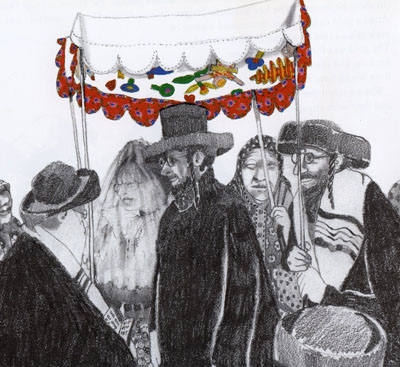
image above: chuppapolacco1.jpg
from Polacco, P. (1998), The Keeping Quilt.
Later in the same book, the same quilt would be used again by the great grandaugher of Sasha, but this time in what appears a Reformed Jewish wedding, "men and women danced together. In my bouquet were gold, bread and salt--and a sprinke of wine, so I would always know laughter" (Polacco).
3. The groom (Chatan in Hebrew) must give the bride (Kallah in Hebrew) something of value such as a ring which should be of pure metal." One source suggested tht the ceremony would be compromised if the metal was not pure. But if authenticated and the bride is certain of the ring as a heritage from the family, it may be used. One can have a simple ring or have Hebrew in wonderful block “aleph-beth” characters inscribed. "
www.jewishbazaar.com
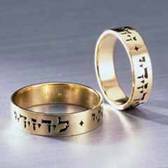
Sometimes there are two rings, one for bride and one for the groom, and in the case of the rings may be inscribed the line from the Song of Solomon," I am my beloved's….."
4. Then the "Seven Blessings" are read with a variety of topics including praise of G-D, thanks for those in attendance, hope ro the restoration of the Holy Temple in Jerusalem (cf. below the language of Rabbi Hillel Cohn regarding the service he sent me.) The bride then walks around the groom 7 times in a circle.
5. The Kiddushin- a blessing said over a cup of wine, from which both bride and groom sip. One interpreter says the wine represents their life together which flows out from the ceremoy, be it bitter or sweet (Jews usually use sweet wine, I learned, after which the Ketubah, which should be written in Aramaic (although it seems possible to have other languages including Japanese as in the Owada wedding above)) is read and signed. For examples of the kinds of Kethubaot, try this web address: http://www.ketubahtree.com.
5. Then the "Seven Blessings" are read with a variety of topics including praise of G-D, thanks for those in attendance, hope for the restoration of the Holy Temple in Jerusalem. For an excellent example see above the Seven Blessings in the ceremony of Rabbi Hillel Cohn.
6. The breaking of a glass by the groom.
7. The Kiss (according to Rabbi Cohn) and the celebration or wedding meal (Se'udah in Hebrew) with good, music, wine and dancing.
I learned that the intent of the celebration was a great commandment to ”Make the groom and bride happy" with dancing singing and more to eat and drink." (Halevy, l972). The groom in the image below does seem happy.
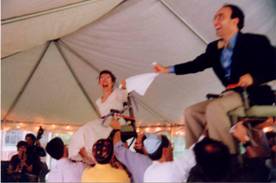
sothor.pair.com/.../chairdance.jpeg
When I was planning a wedding for a bride who had deep Jewish roots, I was especially interested in how much “tradition” she wished in the ceremony. I was given a print out from the web of what would be important in a Jewish wedding. In that case, she desired some Hebrew in the ceremony, so I read (or recited) Psalm 23 in Hebrew, because I knew it. But after the ceremony I was told by a guest that Psalm 23 was NOT the
"official" text for a wedding ceremony, and a"real" rabbi, which clearly I was not, would have memorized the appropriate readings in a rabbinical seminary. I did not tell this opinionated guest that I had once memorized several psalms while at Yale Divinity School. The wedding discussed here was not conducted in a Jewish sanctuary, but somehow the hall came to feel as if it were, especially when the chupah was set up, and when they entered it together. In this wedding, a glass was smashed, ( a light bulb, as I recall.) Also rings were exchanged. In the big reception with many friends, Jews and Gentiles, alike there was a clear attempt to fulfill the great commandment to love. This wedding ceremony was performed by two Protestant clergymen of two different denominations in two quite different garments. The bride and groom wore costumes which they would wear only this once, but the wearing of them made clear that this was indeed a wedding in America.
In my research regarding modern Jewish weddings, I discovered that sometimes modern Jews who find their children are beyond the level of just dating but at a moment before are willing to commit to a mariage are sometimes given a recognized service somewhere between the two levels. I am still looking for the Hebrew word for this relationship. Perhaps no word exists as yet. I was pleased to discern that the Kethuboth for modern Jews is now written so that equality pervades, Renewal communities have introduce some nonsexist touches including provisions in the KETUBAH (marriage conract) that ensure full equality in vows that are written by the couples to reflect the reality of their commitment to each other" (Lerner, 390). Bravo, I felt in reading the paragraph cited, for that is just what I have been doing the last forty years, if not on a KETHUBAH! Moreover "Gay and lesbian commitment ceremonies have been developed (in Jewish-renewal comunites) so that homosexuals may have the same communical support and sanctificaiton of their commitment to each other' (Lerner, 390).
During research for the "album project," I wanted to determine what a wedding ceremony was like in present day Israel. During my one sojourn there a decade ago, during Passover, I saw no weddings, nor would I very likely have “crashed” one. I learned that in Israel all authority over marriage of Jews in that country is under the control of Orthodox rabbis and by law the only marriages which are recognized there were performed by Orthodox rabbis for Jewish couples or in civil ceremonies abroad. Therefore, “the Orthodox culture represents, in many ways, a sort of anti-culture to the rest of Israeli society. As a result, the right to marry according to one’s own world-view is for many seculars a matter of principle. A claim often hear is: we would like to have a Jewish ceremony but resent the strict and unequal character of the Orthodox ceremony, and the fact that the state prohibits freedom of choice in marriages.” (Oz, 74). So the couple who wishes a wedding ceremony in the Reform or Conservative traditions or in a secular ceremony can, indeed, have one, BUT they must still have a civil marriage abroad recorded through the Ministry of the Interior. Some efforts are going on at the national level for changes to these laws. I was glad to know the weddings of Jews that I had attended in America were the real ceremony and did not have to be done before a civil authority.
Below is an image of a poster with a translation of the Medieveal Mystic Baal Shem Tov. It hangs in my office as an inspirtation to all those seeking to find a partner in life and perhaps as appropriate to Jews and Gentiles as well.

|